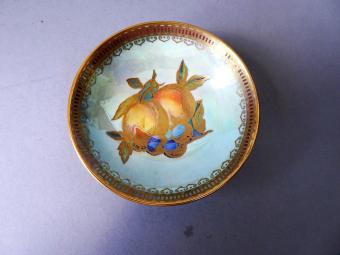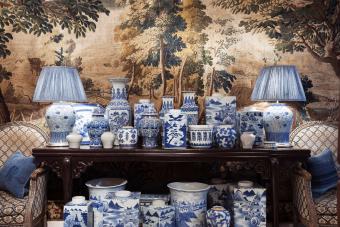
There's nothing that sends spring cleaning downhill faster than trying to find a safe spot to store your grandmother's china. While you're dusting off plates and teacups, take a look and see if you have any Wedgwood on your hands. Antique Wedgwood china is as valuable as it is beautiful, and it's worth the fuss to store.
Valuable Wedgwood China Worth More Than Your College Tuition
Since 1759, Wedgwood has been cranking out stunning dinner service sets and decorative pieces for the English elite. In 1765, founder and artisan Josiah Wedgwood even crafted a complete set of dishes for Queen Charlotte.
This little engine that could is one of the rare examples of 18th-century companies that continue to evolve to match modern styles. From Majorlica to Japserware, these are some of the most expensive Wedgwood pieces ever sold.
| Wedgwood China | Recent Sales Prices |
| Wedgwood Basaltes First Days' Vase | $613,981.25 |
| Wedgwood Green Jasperware Vase Set | $70,305.63 |
| Wedgwood Majolica Punchbowl | $32,067 |
Wedgwood Basaltes First Days' Vase: $613,981.25
Some of the earliest Wedgwood pieces were elaborately decorated vases. If you've ever seen the aftermath of a kid racing through a hallway on brand-new roller skates, then you know how hard it is to keep delicate things intact. So, 18th century Wedgwood always sells for a lot of money. For example, this Wedgwood vase from 1769, painted with orange encaustic enamel to mimic Ancient Greek frescoes, sold for about $614,000 in 2016.
Wedgwood Green Jasperware Vase Set: $70,305.63
Another high-earner at auction is Jasperware. This matte 19th-century style is just as refined as the company's earlier works. Though Jasperware comes in multiple colors, this specific set was painted a lovely sage green. Made circa 1870, this vase duo sold for an impressive $70,305.63 in 2011.
Wedgwood Majolica Punchbowl: $32,067
Majolica is another prominent Wedgwood syle, using a lead-glazing technique to create punchy, saturated colors that Victorians went wild over. Looking at them through a 21st-century lens, they give off strong anachronistic vibes. After all, who expects a punchbowl with Punch (the character) popping out of the sides like a ship's figurehead to have an audience in 1877?
But this punchbowl obviously had its fans because it sold at auction for $32,067 in 2005.
What Makes Wedgwood China Valuable?
While you can find some newer, less collectible Wedgewood pieces for under $10, the more desirable items sell for hundreds or thousands. Wedgwood china values depend on multiple factors, including their age, style, and condition.

The Older, the Better
From a purist's point of view, antique Wedgwood china was created before 1910. Meanwhile, vintage Wedgwood china patterns encapsulate any pattern that was manufactured between 1910 and 1985.
But, the older the Wedgwood china is, the more money it's going to be worth. Eighteenth-century and early 19th-century Wedgwood china is rare, making any that come to auction big ticket items.
Tableware vs. Studio Pieces
Generally, studio pieces are more valuable than tableware. If it's a dinner service, tea set, or similar collection, it'll still have value, especially when it's a completed set.
However, if you have a studio piece made by an artisan, it's almost always worth more. Note that most studio pieces are numbered and many Fairyland pieces are considered studio Wedgewood. Collectors love antique and vintage Wedgwood vases in particular.
Condition Makes a Big Difference
Like any fragile item, Wedgwood china is prone to cracks, breaks, and discoloring over time. If you have a piece in good condition, it'll be worth more than a similar piece with damage.
How to Identify Vintage Wedgwood China
Wedgwood china is a relatively easy china to identify because the company has almost always marked their designs. Take a closer look at the different maker's marks and date stamps you might come across.
Look for the Wedgwood Mark
Almost all Wedgwood is stamped, although there have been several different stamps over their 250+ year period. Wedgwood almost always has a maker's mark with a signature rather than just a symbol.
These marks normally say one of three things:
- Wedgwood England
- Wedgwood, Made in England
- Wedgwood of Etruria & Barlaston
You may also see an urn with the word "Wedgwood" printed underneath it. The urn is the only image included in any Wedgwood markings.
How to Read the Date Stamp
After 1860, Wedgwood began to use a three-letter stamp to indicate the date the piece was manufactured. The first letter stands for the month, the second for the potter, and the third for the year.
Understanding how this works can be a challenge, but we've got a cheat sheet to make things easier.
| Month | Letter Code |
|---|---|
| January | J |
| February | F |
| March | M (1860-1863), R (1864 and after) |
| April | A |
| May | Y (1860-1863), M (1864 and after) |
| June | T |
| July | V (1860-1863), L (1864 and after) |
| August | W |
| September | S |
| October | O |
| November | N |
| December | D |
The year codes begin with 1860 and O and continue on until Z in 1871. At that point, the letter code begins again with A in 1872. Because of this, some letters are used for more than one year.
Related: Antique Majolica: One of Wedgwood's Beautiful Ceramic Collectibles
4 Popular Wedgewood Styles to Know
Wedgwood made dozens of china patterns over their 200+ years in business. By the 20th century, they'd wisened up to an easier way to identify their pieces. For Wedgwood patterns made after 1962, you can usually find the pattern name printed on the back. For other patterns, it's a good idea to consult a pattern book with every pattern listed, such as Wedgwood: A Collector's Guideby Peter Williams.
On top of patterns, Wedgwood specialized in a few unique styles. Four of their most popular are Jasperware, Queen's Ware, Fairyland Lustre, and Majolica.
Jasperware
Developed by Josiah Wedgwood in the 1770s, this beautiful pattern has a matte base layer with raised, usually white, relief decorations. The base layer is often light blue, but it can also be green, black, dark blue, yellow, and other shades.

Queen's Ware
Patterned after the tea set Josiah Wedgwood made for Queen Charlotte in 1765, Queen's Ware is another very popular pattern. It's a lustrous and elegant cream-on-cream design that is a classic choice.

Fairyland Lustre
Susannah Margaretta "Daisy" Makeig-Jones was a designer who worked for Wedgwood in the early 20th century. She created the iconic Fairyland Lustre pattern in 1915, which features hand-painted decorations and an iridescent glaze.

Majolica
Wedgwood Majolica features nature-inspired designs, often in a tone-on-tone color scheme. Many of these were made during the late 1900s in the Art Nouveau style.
4 Tips to Help You Care for a Wedgwood Collection
For many, Wedgwood is an heirloom that they'd like to treasure for generations. But for your future family to enjoy your Wedgwood collection, you've got to take care of it properly.
- Keep Wedgwood china out of direct sunlight. Sunlight can fade paint and patterns over time.
- Store your Wedgwood in protected places. For example, a glass-front cabinet will help protect your pieces and display them nicely.
- Always wash Wedgwood dishes with a gentle soap. Rinse thoroughly in warm water and let air dry before storing again.
- Consider storing your delicate pieces in soft, flannel bags. These keep them dust free and will pad and protect them from accidental chips.
Family Heirlooms in the Making
Collecting antique china is a fun and (sometimes) low-cost hobby. Head to any local antique store, and you'll see that the options are endless. Wedgwood is just one of the wonderful possibilities. From antique bone china to Limoges dinnerware, you're sure to find the perfect piece.







